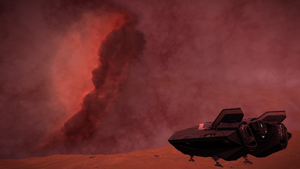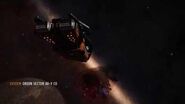(Added a video) Tag: Visual edit |
No edit summary |
||
| Line 1: | Line 1: | ||
[[File:Barnard%27s-Loop.png||thumb|300px|Barnard's Loop]] |
[[File:Barnard%27s-Loop.png||thumb|300px|Barnard's Loop]] |
||
| + | '''Barnard's Loop''' is an immense [[nebula]] in the [[Inner Orion Spur]] named after the pioneering astrophotographer [[wikipedia:Edward Emerson Barnard|Edward Emerson Barnard]]; Barnard documented the gas cloud in 1894, though it was also likely observed by earlier astronomers. It is approximately 300 light years across, and is thought to have originated from a supernova two million years ago. The stars AE Aurigae, Mu Columbae, and 53 Arietis are believed to have been byproducts of the supernova. |
||
| + | In the 34th century, Barnard's Loop is one of the most ubiquitous visual features in space visible from the [[Core Systems]]. Many [[explorer]]s make a point of visiting it, and the Trapezium Sector AF-Z c0 system is one of several ideal observation spots. |
||
| − | '''Barnard's Loop''' is an immense gas cloud named after the long-deceased pioneering astrophotographer Edward Emerson Barnard. |
||
| − | |||
| − | The Loop stretches for hundreds of light years and is full of stars, but the central cloud is relatively empty, save for a few unremarkable T Tauris, red and orange dwarves. But, surprisingly, it's one of those dim reddish stars right at the center that hides a wonder more valuable than any neutron remnant or a black hole. The center of Barnard's Loop is very pink and light red. |
||
== Videos == |
== Videos == |
||
| Line 9: | Line 8: | ||
File:Elite_Dangerous_SRV_Exploring_near_Barnard%27s_Loop |
File:Elite_Dangerous_SRV_Exploring_near_Barnard%27s_Loop |
||
</gallery> |
</gallery> |
||
| − | |||
[[Category:Nebulae]] |
[[Category:Nebulae]] |
||
Revision as of 02:20, 17 July 2019

Barnard's Loop
Barnard's Loop is an immense nebula in the Inner Orion Spur named after the pioneering astrophotographer Edward Emerson Barnard; Barnard documented the gas cloud in 1894, though it was also likely observed by earlier astronomers. It is approximately 300 light years across, and is thought to have originated from a supernova two million years ago. The stars AE Aurigae, Mu Columbae, and 53 Arietis are believed to have been byproducts of the supernova.
In the 34th century, Barnard's Loop is one of the most ubiquitous visual features in space visible from the Core Systems. Many explorers make a point of visiting it, and the Trapezium Sector AF-Z c0 system is one of several ideal observation spots.

